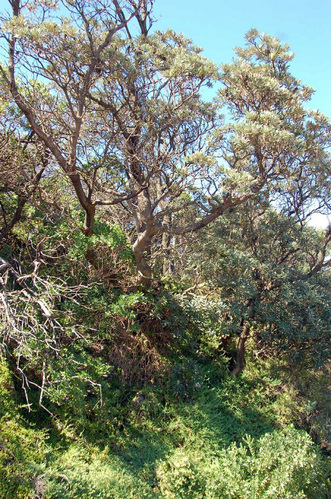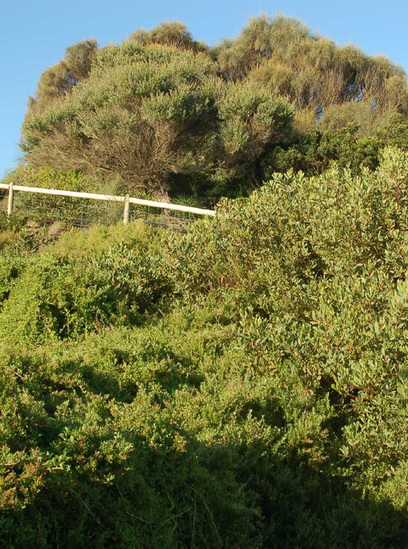for a list of volunteer environmental groups in your area of the Peninsula, see this page
Environmental restoration of the coastal reserve between
Williams Road & Jacksons Road, in Mt Eliza

History
The Friends of Williams Road Beach was initiated by Baden Powell Park Scout Group who, in 2003, assumed responsibility for the former Mount Eliza Sea Scout hall. During the initial phase, scouts and a pre-existing Work-for-the-Dole Crew undertook restoration activities around the scout hall. By early 2005 a broad-based community group, the Friends of Williams Road Beach had been established. It operates as a Mornington Peninsula Shire Friends Group, supported by scouting, the general public and environmental groups.
The target area, the foreshore between Williams and Jacksons Roads, had been subjected to extensive tipping and soil disturbance. This resulted in depleted vegetation and heavy infestations of Polygala and a range of aggressive weeds, including Rambling Dock, Dolichus and Pampas Lily of the Valley.
Restoration
Restoration of the site has required intensive planning and long-term commitment. Weed removal takes place at three levels: the maintenance of established indigenous vegetation; the weeding of new and adjoining areas; and concurrently, the monitoring and, when necessary, treatment of aggressive weeds throughout the reserve.
In those areas still supporting natural seedbed, removal of woody weeds, followed by minimal disturbance hand-weeding, has resulted in reactivation of indigenous vegetation. In the Coast Banksia Woodland the scattering of fallen Banksia branches, with ripe cones, has promoted natural recruitment.
At disturbed locations, without indigenous seedbed, supplementary planting has been required. This has been undertaken through the propagation of site indigenous plants. A Department of Sustainability and Environment permit for the collection of plant material and seed has been obtained and is regularly renewed.
Meticulous adherence to established methodology has brought excellent results: vastly reduced weeds in retention areas; increased biodiversity and habitat; and the joining of sites once fragmented.
The Friends of Williams Road Beach was initiated by Baden Powell Park Scout Group who, in 2003, assumed responsibility for the former Mount Eliza Sea Scout hall. During the initial phase, scouts and a pre-existing Work-for-the-Dole Crew undertook restoration activities around the scout hall. By early 2005 a broad-based community group, the Friends of Williams Road Beach had been established. It operates as a Mornington Peninsula Shire Friends Group, supported by scouting, the general public and environmental groups.
The target area, the foreshore between Williams and Jacksons Roads, had been subjected to extensive tipping and soil disturbance. This resulted in depleted vegetation and heavy infestations of Polygala and a range of aggressive weeds, including Rambling Dock, Dolichus and Pampas Lily of the Valley.
Restoration
Restoration of the site has required intensive planning and long-term commitment. Weed removal takes place at three levels: the maintenance of established indigenous vegetation; the weeding of new and adjoining areas; and concurrently, the monitoring and, when necessary, treatment of aggressive weeds throughout the reserve.
In those areas still supporting natural seedbed, removal of woody weeds, followed by minimal disturbance hand-weeding, has resulted in reactivation of indigenous vegetation. In the Coast Banksia Woodland the scattering of fallen Banksia branches, with ripe cones, has promoted natural recruitment.
At disturbed locations, without indigenous seedbed, supplementary planting has been required. This has been undertaken through the propagation of site indigenous plants. A Department of Sustainability and Environment permit for the collection of plant material and seed has been obtained and is regularly renewed.
Meticulous adherence to established methodology has brought excellent results: vastly reduced weeds in retention areas; increased biodiversity and habitat; and the joining of sites once fragmented.
Natural Values

Bottom to top: Seaberry Saltbush, Boobialla, Beard-heath, Tea-tree and Sheoak
A continuous band of Coastal Headland Scrub now extends along the rise from the Williams Road bluff to Jacksons Road. Twenty five species are abundant in this plant community. The area features a large stand of Drooping Sheoak, many mature Sea Box and Common Boobialla. Coast Beard-heath is also represented. Seaberry Saltbush and Bower Spinach provide understorey habitat. Small-flower Flax-lily, Climbing Lignum and Small-leaved Clematis are prevalent.
The Coast Banksia Woodland is situated in deep sands around and to the south of the scout hall.The area supports some remnant vegetation Coast Banksias and well-established natural recruitment Banksias. Other trees and scrubs include Coast Tea-tree, Common Boobialla, Coast Beard-heath and White Correa. Australian saltgrass and other remnant ground flora is being augmented through the establishment of succulent and salt-tolerant vegetation, including Seaberry saltbush and Bower spinach.
The reserve at large supports four regionally significant plants, including Common Wallaby Grass, Ruby Saltbush, Coast Bonefruit and some Common Eutaxia.
Restoration of indigenous vegetation has done much to restore the areas strong sense of place. However, a unified vision of terrestrial and marine habitats gives true perspective.
The coastline from Pelican Point, south to Williams Road is protected by an extensive inter-tidal rock platform. Pelicans and cormorants can frequently be seen on rocky outcrops. During late winter and spring hundreds of gannets and terns plummet for baitfish. Occasionally, dolphins join the feeding frenzy. It is not surprising that this coastline played an integral part in the lives of indigenous communities. Extensive shell middens are located along the length of the Canadian Bay Cove.
The Coast Banksia Woodland is situated in deep sands around and to the south of the scout hall.The area supports some remnant vegetation Coast Banksias and well-established natural recruitment Banksias. Other trees and scrubs include Coast Tea-tree, Common Boobialla, Coast Beard-heath and White Correa. Australian saltgrass and other remnant ground flora is being augmented through the establishment of succulent and salt-tolerant vegetation, including Seaberry saltbush and Bower spinach.
The reserve at large supports four regionally significant plants, including Common Wallaby Grass, Ruby Saltbush, Coast Bonefruit and some Common Eutaxia.
Restoration of indigenous vegetation has done much to restore the areas strong sense of place. However, a unified vision of terrestrial and marine habitats gives true perspective.
The coastline from Pelican Point, south to Williams Road is protected by an extensive inter-tidal rock platform. Pelicans and cormorants can frequently be seen on rocky outcrops. During late winter and spring hundreds of gannets and terns plummet for baitfish. Occasionally, dolphins join the feeding frenzy. It is not surprising that this coastline played an integral part in the lives of indigenous communities. Extensive shell middens are located along the length of the Canadian Bay Cove.
Access
To enjoy this foreshore reserve, access the track on the north side of the Williams Road carpark.
Walk through to Jacksons Road and return via the beach and the scout hall track.
Alternatively, join the Friends of Williams Road Beach on alternate Fridays, between mid-March and mid-October.
Working bees are held between 10 am and 3 pm at the foreshore scout hall.
For further details please phone Ann Scholes on 9787 7228 or e-mail her at [email protected]
To enjoy this foreshore reserve, access the track on the north side of the Williams Road carpark.
Walk through to Jacksons Road and return via the beach and the scout hall track.
Alternatively, join the Friends of Williams Road Beach on alternate Fridays, between mid-March and mid-October.
Working bees are held between 10 am and 3 pm at the foreshore scout hall.
For further details please phone Ann Scholes on 9787 7228 or e-mail her at [email protected]
for a list of volunteer environmental groups in your area of the Peninsula, see this page
go to the home page
go to the home page

